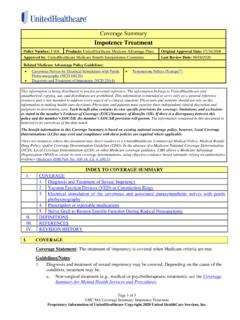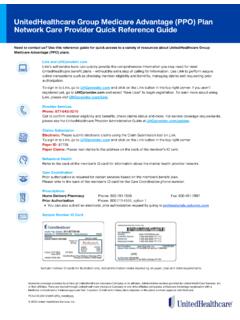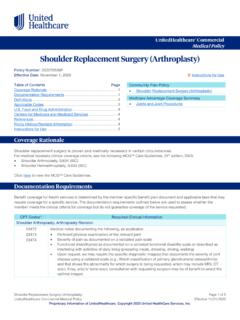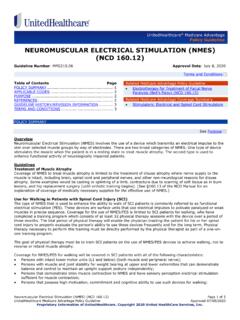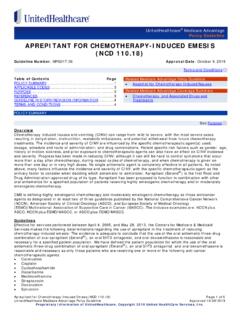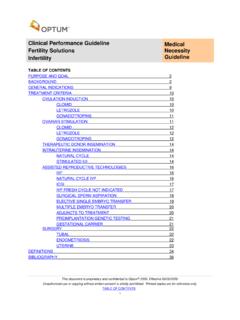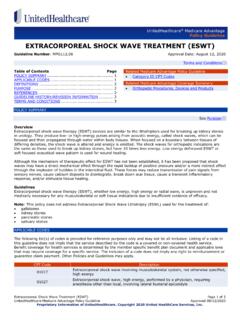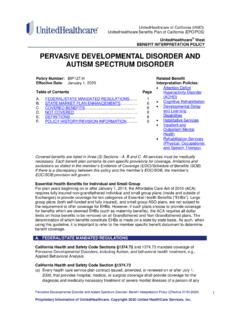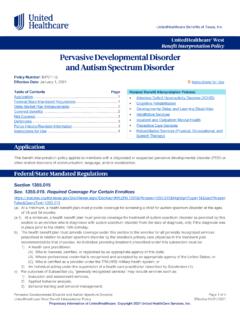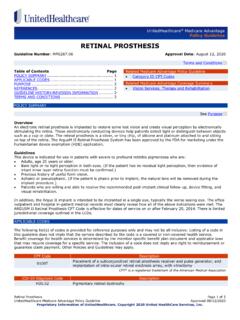Transcription of Obstetrical Ultrasound Policy, Professional
1 Reimbursement Policy CMS-1500. Policy Number 2022R7112A. Obstetrical Ultrasound Policy, Professional IMPORTANT NOTE ABOUT THIS REIMBURSEMENT POLICY. You are responsible for submission of accurate claims. This reimbursement policy is intended to ensure that you are reimbursed based on the code or codes that correctly describe the health care services provided. UnitedHealthcare Community Plan reimbursement policies uses Current Procedural Terminology (CPT *), Centers for Medicare and Medicaid Services (CMS) or other coding guidelines. References to CPT or other sources are for definitional purposes only and do not imply any right to reimbursement. This reimbursement policy applies to all health care services billed on CMS 1500 forms and, when specified, to those billed on UB04 forms. Coding methodology, industry-standard reimbursement logic, regulatory requirements, benefits design and other factors are considered in developing reimbursement policy.
2 This information is intended to serve only as a general reference resource regarding UnitedHealthcare Community Plan's reimbursement policy for the services described and is not intended to address every aspect of a reimbursement situation. Accordingly, UnitedHealthcare Community Plan may use reasonable discretion in interpreting and applying this policy to health care services provided in a particular case. Further, the policy does not address all issues related to reimbursement for health care services provided to UnitedHealthcare Community Plan enrollees. Other factors affecting reimbursement supplement, modify or, in some cases, supersede this policy. These factors include, but are not limited to: federal &/or state regulatory requirements, the physician or other provider contracts, the enrollee's benefit coverage documents, and/or other reimbursement, medical or drug policies.
3 Finally, this policy may not be implemented exactly the same way on the different electronic claims processing systems used by UnitedHealthcare Community Plan due to programming or other constraints; however, UnitedHealthcare Community Plan strives to minimize these variations. UnitedHealthcare Community Plan may modify this reimbursement policy at any time by publishing a new version of the policy on this Website. However, the information presented in this policy is accurate and current as of the date of publication. *CPT Copyright American Medical Association. All rights reserved. CPT is a registered trademark of the American Medical Association. Application This reimbursement policy applies to UnitedHealthcare Community Plan Medicaid products. This reimbursement policy applies to services reported using the 1500 Health Insurance Claim Form (a/k/a CMS-1500).
4 Or its electronic equivalent or its successor form. This policy applies to all products and all network and non-network physicians and other qualified health care professionals, including, but not limited to, non-network authorized and percent of charge contract physicians and other qualified health care professionals. Policy Overview UnitedHealthcare Community Plan considers ultrasounds not medically necessary if done solely to determine the fetal sex, or to provide parents with a view and photograph of the fetus. Detailed Ultrasound fetal anatomic examination is not considered medically necessary for routine screening of normal pregnancy. The American College of Obstetricians and Gynecologists (ACOG) recommends that in the absence of specific indications, the optimal time for an obstetric (OB) Ultrasound examination is between 18 - 20 weeks of gestation because anatomically complex organs, such as the fetal heart and brain, can be imaged with sufficient clarity to allow detection of many major malformations.
5 This recommendation is based primarily on consensus and expert opinion (Level C). ACOG stated that it may be possible to document normal structures before 18 weeks of gestation but some structures can be difficult to visualize at that time because of fetal size, position, and movement; maternal abdominal scars; and increased maternal abdominal wall thickness. A second or third trimester Ultrasound examination, however, may pose technical limitations for an anatomic evaluation due to suboptimal imaging, and when this occurs, ACOG. recommended documentation of the technical limitation and that a follow-up examination may be helpful. This policy is based in part on the (ACOG) Practice Bulletin on Ultrasonography in Pregnancy and guidelines from the Society for Maternal-Fetal Medicine (SMFM). Proprietary information of UnitedHealthcare Community Plan.
6 Copyright 2022 United HealthCare Services, Inc. 2022R7112A. Reimbursement Policy CMS-1500. Policy Number 2022R7112A. Reimbursement Guidelines Indications for an OB Ultrasound include: To confirm cardiac activity To confirm the presence of an intrauterine pregnancy To evaluate a suspected ectopic pregnancy To evaluate maternal pelvic or adnexal masses or uterine abnormalities As adjunct to amniocentesis or other procedures such as cervical cerclage placement, external cephalic version, chorionic villus sampling, embryo transfer, or localization and removal of an intrauterine device To assess for certain fetal anomalies, such as anencephaly, in patients at high risk Follow-up evaluation of a fetal anomaly Determination of fetal presentation Estimation of gestational age evaluation for abnormal biochemical markers evaluation for fetal well-being evaluation for premature rupture of membranes of premature labor evaluation in those with a history of previous congenital anomaly evaluation of abdominal and pelvic pain evaluation of cervical insufficiency evaluation of fetal condition in late registrants for prenatal care evaluation of fetal growth evaluation of suspected amniotic fluid abnormalities evaluation of suspected fetal death evaluation of suspected multiple gestation evaluation of suspected placental abruption evaluation of suspected uterine abnormality evaluation of vaginal bleeding Examination of suspected hydatidiform
7 Mole Follow-up evaluation of placental location for suspected placenta previa Significant discrepancy between uterine size and clinical dates To assess for findings that may increase the risk of aneuploidy OB Ultrasound Codes Standard (Routine) Fetal Ultrasound Codes: 76801, 76802, 76805, 76810, 76815, & 76816. Detailed Fetal Ultrasound Codes: 76811 & 76812. UnitedHealthcare Community Plan considers a fetal Ultrasound with detailed anatomic examination medically necessary to evaluate the fetus for amniotic band syndrome (also known as amniotic constriction band syndrome), or if there are known or suspected fetal anatomic abnormalities, including anatomic abnormalities due to genetic conditions. There is inadequate evidence of the clinical utility of multiple serial detailed fetal anatomic Ultrasound examinations during pregnancy.
8 UnitedHealthcare Community Plan considers detailed Ultrasound fetal anatomic examination experimental and investigational for all other indications including routine evaluation of pregnant women who are on bupropion (Wellbutrin), and pregnant women who smoke or abuse cannabis. There is inadequate evidence of the clinical utility of detailed Ultrasound fetal anatomic examination for indications other than evaluation of suspected fetal anatomic abnormalities. OB Ultrasound Limits UnitedHealthcare Community Plan Medicaid allows the first three OB ultrasounds per pregnancy. OB Ultrasound codes are: 76801, 76802, 76805, 76810, 76811, 76812, 76813, 76814, 76815, 76816, 76817, & 76819. Unless a different limit is outlined by the State, claims for the fourth and/or subsequent OB Ultrasound procedure per pregnancy must contain a high risk pregnancy diagnosis code.
9 High risk is defined by a diagnosis code from the UnitedHealthcare Community Plan Medicaid ICD-10-CM Detailed and High Risk Fetal Ultrasound Diagnosis list. Proprietary information of UnitedHealthcare Community Plan. Copyright 2022 United HealthCare Services, Inc. 2022R7112A. Reimbursement Policy CMS-1500. Policy Number 2022R7112A. For place of service 23 (emergency room/department) a fourth and/or subsequent OB Ultrasound procedure per pregnancy must contain either an OB pregnancy diagnosis code from the UnitedHealthcare Community Plan Medicaid ICD-10-CM Pregnancy Fetal Ultrasound Diagnosis list or a high risk pregnancy diagnosis code from the UnitedHealthcare Community Plan Medicaid ICD-10-CM Detailed and High Risk Fetal Ultrasound Diagnosis list. UnitedHealthcare Community Plan ICD-10-CM Pregnancy Fetal Ultrasound Diagnosis List UnitedHealthcare Community Plan Medicaid ICD-10-CM Detailed and High Risk Fetal Ultrasound Diagnosis list Additional Background and Sources The SMFM has stated that a fetal Ultrasound with detailed anatomic examination (CPT 76811) is not necessary as a routine scan for all pregnancies (2004).
10 Rather, this scan is necessary for a known or suspected fetal anatomic or genetic abnormality ( , previous anomalous fetus, abnormal scan during pregnancy, etc.). Thus, the SMFM has stated that the performance of this scan is expected to be rare outside of referral practices with special expertise in the identification of, and counseling about, fetal abnormalities (SMFM, 2004). A focused Ultrasound assessment is sufficient for follow-up to provide a reexamination of a specific organ or system known or suspected to be abnormal, or when doing a focused assessment of fetal size by measuring the bi-parietal diameter, abdominal circumference, femur length, or other appropriate measurements (SMFM, 2004). An Ultrasound without detailed anatomic examination is appropriate for a fetal maternal evaluation of the number of fetuses, amniotic/chorionic sacs, survey of intracranial, spinal and abdominal anatomy, evaluation of a 4-chamber heart view, assessment of the umbilical cord insertion site, assessment of amniotic fluid volume, and evaluation of maternal adnexa when visible and appropriate (SMFM, 2004).
